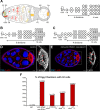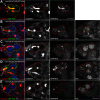Abscission is regulated by the ESCRT-III protein shrub in Drosophila germline stem cells
- PMID: 25647097
- PMCID: PMC4372032
- DOI: 10.1371/journal.pgen.1004653
Abscission is regulated by the ESCRT-III protein shrub in Drosophila germline stem cells
Abstract
Abscission is the final event of cytokinesis that leads to the physical separation of the two daughter cells. Recent technical advances have allowed a better understanding of the cellular and molecular events leading to abscission in isolated yeast or mammalian cells. However, how abscission is regulated in different cell types or in a developing organism remains poorly understood. Here, we characterized the function of the ESCRT-III protein Shrub during cytokinesis in germ cells undergoing a series of complete and incomplete divisions. We found that Shrub is required for complete abscission, and that levels of Shrub are critical for proper timing of abscission. Loss or gain of Shrub delays abscission in germline stem cells (GSCs), and leads to the formation of stem-cysts, where daughter cells share the same cytoplasm as the mother stem cell and cannot differentiate. In addition, our results indicate a negative regulation of Shrub by the Aurora B kinase during GSC abscission. Finally, we found that Lethal giant discs (lgd), known to be required for Shrub function in the endosomal pathway, also regulates the duration of abscission in GSCs.
Conflict of interest statement
The authors have declared that no competing interests exist.
Figures








Similar articles
-
ALIX and ESCRT-III coordinately control cytokinetic abscission during germline stem cell division in vivo.PLoS Genet. 2015 Jan 30;11(1):e1004904. doi: 10.1371/journal.pgen.1004904. eCollection 2015 Jan. PLoS Genet. 2015. PMID: 25635693 Free PMC article.
-
Lethal Giant Disc is a target of Cdk1 and regulates ESCRT-III localization during germline stem cell abscission.Development. 2024 Apr 15;151(8):dev202306. doi: 10.1242/dev.202306. Epub 2024 Apr 16. Development. 2024. PMID: 38546617
-
Lethal (2) giant discs (Lgd)/CC2D1 is required for the full activity of the ESCRT machinery.BMC Biol. 2020 Dec 22;18(1):200. doi: 10.1186/s12915-020-00933-x. BMC Biol. 2020. PMID: 33349255 Free PMC article.
-
Knowing when to cut and run: mechanisms that control cytokinetic abscission.Trends Cell Biol. 2013 Sep;23(9):433-41. doi: 10.1016/j.tcb.2013.04.006. Epub 2013 May 22. Trends Cell Biol. 2013. PMID: 23706391 Review.
-
Incomplete divisions between sister germline cells require Usp8 function.C R Biol. 2024 Sep 30;347:109-117. doi: 10.5802/crbiol.161. C R Biol. 2024. PMID: 39345214 Review.
Cited by
-
Structural Analysis of the ESCRT-III Regulator Lethal(2) Giant Discs/Coiled-Coil and C2 Domain-Containing Protein 1 (Lgd/CC2D1).Cells. 2024 Jul 10;13(14):1174. doi: 10.3390/cells13141174. Cells. 2024. PMID: 39056756 Free PMC article.
-
The Flemmingsome reveals an ESCRT-to-membrane coupling via ALIX/syntenin/syndecan-4 required for completion of cytokinesis.Nat Commun. 2020 Apr 22;11(1):1941. doi: 10.1038/s41467-020-15205-z. Nat Commun. 2020. PMID: 32321914 Free PMC article.
-
Tissue topography steers migrating Drosophila border cells.Science. 2020 Nov 20;370(6519):987-990. doi: 10.1126/science.aaz4741. Science. 2020. PMID: 33214282 Free PMC article.
-
Two distinct waves of transcriptome and translatome changes drive Drosophila germline stem cell differentiation.EMBO J. 2024 Apr;43(8):1591-1617. doi: 10.1038/s44318-024-00070-z. Epub 2024 Mar 13. EMBO J. 2024. PMID: 38480936 Free PMC article.
-
Reduced Levels of Lagging Strand Polymerases Shape Stem Cell Chromatin.bioRxiv [Preprint]. 2024 Apr 29:2024.04.26.591383. doi: 10.1101/2024.04.26.591383. bioRxiv. 2024. Update in: Sci Adv. 2025 Feb 28;11(9):eadu6799. doi: 10.1126/sciadv.adu6799. PMID: 38746451 Free PMC article. Updated. Preprint.
References
-
- Sanger JM, Pochapin MB, Sanger JW (1985) Midbody sealing after cytokinesis in embryos of the sea urchin Arabacia punctulata. Cell Tissue Res 240: 287–292. - PubMed
-
- Pepling ME, de Cuevas M, Spradling AC (1999) Germline cysts: a conserved phase of germ cell development? Trends Cell Biol 9: 257–262. - PubMed
MeSH terms
Substances
LinkOut - more resources
Full Text Sources
Other Literature Sources
Medical
Molecular Biology Databases
Research Materials

